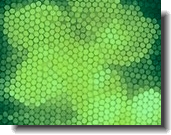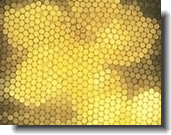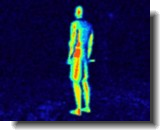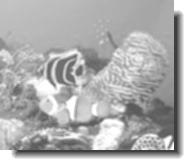
How Animals See The World:





Horse Vision:
Horses and similar animals such as zebras have their eyes pointing sideways (as opposed to straight ahead) in order to give them outstanding peripheral vision. This will give them advanced warning of predators, enabling them to escape if necessary. This benefit does come with a few drawbacks, though. For one, these animals will have a blindspot directly in front of their noses (as illustrated in the picture at right). Another disadvantage is a lack of binocular vision. A horse will always see two images, and cannot merge the images together like a human can (right). Although horses have better night vision than humans, their color vision is rather poor. They can make out greens and blues, but a horse's sight is mostly in shades of gray.
Horses and similar animals such as zebras have their eyes pointing sideways (as opposed to straight ahead) in order to give them outstanding peripheral vision. This will give them advanced warning of predators, enabling them to escape if necessary. This benefit does come with a few drawbacks, though. For one, these animals will have a blindspot directly in front of their noses (as illustrated in the picture at right). Another disadvantage is a lack of binocular vision. A horse will always see two images, and cannot merge the images together like a human can (right). Although horses have better night vision than humans, their color vision is rather poor. They can make out greens and blues, but a horse's sight is mostly in shades of gray.


Bee Vision:
The bee also uses compound eyes, but cannot see the color red. Their visual world is mostly made up of yellow, green, and blue. They can, however, see the ultraviolet spectrum. Honeybees also have three additional eyes called "ocelli" that can't make out images, but are sensitive to light.
The bee also uses compound eyes, but cannot see the color red. Their visual world is mostly made up of yellow, green, and blue. They can, however, see the ultraviolet spectrum. Honeybees also have three additional eyes called "ocelli" that can't make out images, but are sensitive to light.
Insect Vision:
Most insects use compound eyes, made up of hundreds or even thousands of tiny lenses placed together in a honeycomb pattern. Contrary to popular belief, the insect does not see hundreds of copies of the same image at once. Rather, each lens makes up a small part of the overall picture, similar to a mosiac or jigsaw puzzle. One compound eye can have from 10 to 30,000 sections, depending on the insect. Dragonflies and Praying Mantises can have the most sections, up to 30,000. Color perception can vary greatly, as well. Some insects such as butterflies can see far more colors than us, while others see far fewer.
Most insects use compound eyes, made up of hundreds or even thousands of tiny lenses placed together in a honeycomb pattern. Contrary to popular belief, the insect does not see hundreds of copies of the same image at once. Rather, each lens makes up a small part of the overall picture, similar to a mosiac or jigsaw puzzle. One compound eye can have from 10 to 30,000 sections, depending on the insect. Dragonflies and Praying Mantises can have the most sections, up to 30,000. Color perception can vary greatly, as well. Some insects such as butterflies can see far more colors than us, while others see far fewer.
Bird Vision:
Daytime birds see a greater range of colors than humans, including ultraviolet light. As humans, we have never actually seen many of these colors, so a bird's actual vision would be very difficult (if not impossible) to emulate here. It is generally accepted that color is much more vibrant in a typical bird's vision than it is in humans. Hunting birds such as the eagle, kestrel and vulture are know to have outstanding binocular vision, enabling them to easily spot prey from thousands of feet away.
Daytime birds see a greater range of colors than humans, including ultraviolet light. As humans, we have never actually seen many of these colors, so a bird's actual vision would be very difficult (if not impossible) to emulate here. It is generally accepted that color is much more vibrant in a typical bird's vision than it is in humans. Hunting birds such as the eagle, kestrel and vulture are know to have outstanding binocular vision, enabling them to easily spot prey from thousands of feet away.

Snake Vision:
Snakes will use their normal eyes during the day, but at night it will change over to its other pair of "eyes". These pit organs can pick up infrared heat signals from warm objects in their surroundings. During the day, a snake's vision is very dependent on movement. In fact, they have been known to ignore (or not notice) any prey that is completely motionless.
Snakes will use their normal eyes during the day, but at night it will change over to its other pair of "eyes". These pit organs can pick up infrared heat signals from warm objects in their surroundings. During the day, a snake's vision is very dependent on movement. In fact, they have been known to ignore (or not notice) any prey that is completely motionless.
Shrimp And Crab Vision:
Shrimps and crabs have the least developed vision on our list. They have compound eyes similar to an insect, but give much less detail. The picture on the right shows what one shrimp would look like to another. Luckily, shrimps and crabs are very good at picking up signals from sudden movements in their surroundings. This is one of their best defences against predators.
Shrimps and crabs have the least developed vision on our list. They have compound eyes similar to an insect, but give much less detail. The picture on the right shows what one shrimp would look like to another. Luckily, shrimps and crabs are very good at picking up signals from sudden movements in their surroundings. This is one of their best defences against predators.
Dog And Cat Vision:
It is generally accepted that dogs and cats are color blind. They only see very pale shades of color, and many have vision that is comparable to a human who is red-green color blind (which means they can't tell the difference between red and green). However, they do have better peripheral and night vision than us, with eyes that are much more sensitive to movement. These traits were helpful when these animals actually had to hunt for a living!
It is generally accepted that dogs and cats are color blind. They only see very pale shades of color, and many have vision that is comparable to a human who is red-green color blind (which means they can't tell the difference between red and green). However, they do have better peripheral and night vision than us, with eyes that are much more sensitive to movement. These traits were helpful when these animals actually had to hunt for a living!
Not all animals see the world as humans do. For many animals, the world is seen in fuzzy shades of gray, or very "washed out" and pale colors. But some animals can see in total darkness, or even see colors beyond the visual spectrum, that humans have never seen. Still others can use binocular vision to spot prey from thousands of feet away. Here's a look at vision from an animal's point of view:
Horse-Eye View
Human-Eye View

Shark Vision:
Although a shark's eyes are similar to ours (both are made up of a retina, lens, iris, cornea and pupil), our visual abilities are quite different. A shark has no retinal cones, and therefore cannot detect colors. In addition, a shark's eyes are designed to pick up as much light as possible, in order to see further in murky waters. But although they can use this extra light to see objects up to 60 feet away, their vision is still not as acute (sharp) as ours.
Although a shark's eyes are similar to ours (both are made up of a retina, lens, iris, cornea and pupil), our visual abilities are quite different. A shark has no retinal cones, and therefore cannot detect colors. In addition, a shark's eyes are designed to pick up as much light as possible, in order to see further in murky waters. But although they can use this extra light to see objects up to 60 feet away, their vision is still not as acute (sharp) as ours.
Contact Lenses | Glaucoma | Just For Fun | Eyeglasses | Eye Doctor | Eye Care And Symptoms | Eye Anatomy | Online Eye Tests | Laser Eye Surgery | Laser Eye Surgery Directory: Canada | Laser Eye Surgery Directory: USA | Laser Eye Surgery Reviews | Submit A Review | Contact Us | Privacy Policy | Sitemap
Copyright 2006-2009 Vision Health

